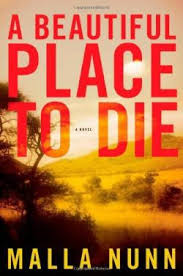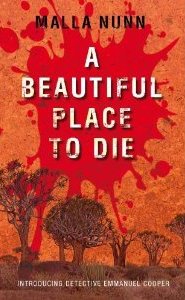Fwoo. This was dark. Which I guess is what I should have expected from a murder mystery that takes places in a small town in apartheid South Africa.
The beginning: British police detective Emmanuel Cooper comes to investigate the murder of an Afrikaner police captain in the small town of Jacob’s Rest. Yes, you read that correctly. It’s a murder mystery where the victim is male. This probably happens more often than it seems to me to happen. I don’t read that many murder mysteries, partly because it always seems to be women getting killed, and I get tired of reading about beautiful lady corpses. I can read about alive ladies doing things that alive people do.
When Aarti reviewed A Beautiful Place to Die recently, I was excited to read a murder mystery by a non-American-or-British author and set in a non-American-or-British place, and as I’ve said, a murder mystery featuring a male corpse. From the get-go, it was clear that the book was going to be a nuanced exploration of racial and gender prejudice, and I was excited for it.
The end (spoilers here, but not spoilers about who did the murder because that is actually the least interesting part of this book and that’s not a criticism): If I had to choose, I’d always go with the I suppose you’re wondering why I’ve brought you here today style of ending. I got anxious reading the ending of A Beautiful Place to Die, which gets pretty violent. Since the book is really about prejudice, the violence that simmers throughout the book rarely has to do with the murderer’s identity, and nearly always has to do with preserving one idea of what people and society are like and how they are supposed to behave.
The whole: My favorite thing about A Beautiful Place to Die is also my least favorite thing about it. Malla Nunn is absolutely wonderful at depicting life in a society that not only condones but (openly) institutionalizes racism. The down side of this is that racial violence is very, very hard for me to read about in fiction. The final third of the book features a healthy dose of race-based violence, as well as (threats of) sexual violence, and if I am going to read about that, I would prefer to read about it in nonfiction.
The up side is that it’s amazing to watch Malla Nunn pick apart the assumptions, large and small, that go into creating a racist society. That she does this while writing from the perspective of a white British man is even more impressive–wonderfully, you can see Emmanuel Cooper being forced to confront his own privilege as he struggles to solve the murder of Captain Willem Pretorius:
She made a sound of disbelief low in her throat. “Only a white man would ask a question like that and expect an answer.”
Emmanuel felt like he was seeing her for the first time. The meek coloured girl he could deal with, even ignore, but this furious sharp-eyed woman was something else altogether.
“What’s the question got to do with my being white?”
“Only white people talk about choice like it’s a box of chocolates that everyone gets to pick from. [A white man] walks into this room and I say what to him? ‘No, thank you, sir, but I do not wish to spoil my chances for a good marriage with a good man from my community, so please ma’ baas take yourself back to your wife and family. I promise not to blackmail you if you promise not to punish my family for turning you away. Thank you for asking me. I am honored.’ Tell me, is that how it works for nonwhite women in Jo’burg, Detective?”
What’s particularly good is that discussions like these come up regardless of Cooper’s good intentions. Although he opposes apartheid and even has some personal experience of racial prejudice (his whiteness, the book suggests early on, may be more fragile than it seems), he’s still able to benefit by it, both in the issues he has to worry about day to day, and in the power he has over any black resident of Jacob’s Rest.
When I said, above, that the identity of the murderer was the least interesting aspect of the book, I didn’t mean to imply that the mystery is a bad one. It isn’t. But the book isn’t exactly about trying to solve a murder. It’s about how it would be to try to solve the murder of an upstanding white citizen in a small racist town where certain paths of investigation are acceptable and others are unacceptable, and you can tell which path is which by the skin color of the people being investigated. Malla Nunn does this spectacularly well, and despite bits of her book being quite upsetting to read, I’m looking forward to reading the next two books in this series.


Cover report: American cover wins. I didn’t choose this one. Both covers were boring to me, so I had Randon choose. He says neither draws him, but he thinks the American cover is better than the British cover.
affiliate links: Amazon, B&N, Book Depository